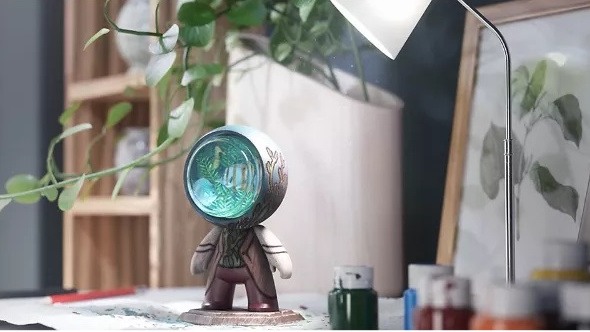Why arts graduates and creatives should consider an IT career
Commentators suggest that future technology jobs will probably involve more creative thinking, with the right non-STEM backgrounds proving essential to cover continued talent shortages

If you haven't got a computer science or engineering degree you could be forgiven for thinking that a solid IT career is not for you, yet IT also needs creative thinkers.
People trained in music, writing, history, literature and drama have all carved out successful careers, even in quite technical roles.
Rebecca Taylor, threat intelligence knowledge manager in the counter threat unit (CTU), has been at Secureworks for nine years after studying creative writing alongside psychology and business. Starting out as a personal assistant, she realised that being "willing to graft" offered her multiple options.
"I moved to business operations, change or project management – then moonlighted in incident command, looking after customers that had experienced attacks like ransomware," she says.
More on getting into the tech industry
Drawn into increasingly technical tasks, by age 24 she was in the CTU full-time, although she'd "never thought" she'd be "good enough".
Taylor's responsibilities include capturing and ingesting multiple indicator types from diverse sources, making sure they're standardised and that "good, robust" processes and procedures around them are usable, accessible and searchable for the teams that most need them.
With a writing background, she could absorb, learn and engage with unfamiliar knowledge and jargon and express herself effectively – although she has supplemented with technical and on-the-job training, she says, to ensure she can "own her space" even in a room with more technical people.
Sign up today and you will receive a free copy of our Future Focus 2025 report - the leading guidance on AI, cybersecurity and other IT challenges as per 700+ senior executives
"There were elements of 'running fast' (to catch up), but that pressure was more of a personal choice," Taylor says. "It was about exposure, having great mentors and sponsors that could lift me up and help me network and find the right answers.
Getting a foot in the door for non-STEM graduates
Jessie Hommelhoff, chief people officer at consultancy Monstarlab, agrees talent shortages should push firms to be more creative themselves about finding candidates.
"For the types of roles we need in future, it is critical for arts and humanities people to work with STEM folk with a broad spectrum approach to tech problems," Hommelhoff says.
"Sometimes we can get narrow-minded – yet few of us desire a world that's completely automated and machine-driven."
Arts and humanities study can improve the understanding of people and their motivations, while how humans interact with certain technologies and digital is critical to product success. Partnering 'arts skills' with STEM backgrounds in house, having them work more closely together, can reshape projects, processes and products, Hommelhoff suggests.
Robin MacDonald, director of Harvey Nash NextGen, warns that although tech is proving increasingly attractive to candidates from both STEM and non-STEM backgrounds, not every arts or humanities student has the makings of a good programmer.
More on the best IT courses
Non-STEM candidates, however, can demonstrate useful cognitive and analytical capabilities in cross-training or coding bootcamps to get a foot in the door; there are also plenty of less technical opportunities if they understand the vision, future and purpose of a technology and its positioning, he says.
"Liberal arts degree-qualified candidates who can utilize analytical capability and skills through things like automation can support applications running in a commercial or production environment," MacDonald suggests.
"We support young people who come from diverse backgrounds – and others – and help upskill them to be valued by a client who's probably used to hiring senior consultants or senior technologists."
At NextGen, they often use logical deduction and spatial reasoning tests, for instance, alongside "a demonstrable desire to become a technologist" to uncover the right candidates to bring forward in the programme for specific clients' needs.
Their academy programmes are looking to overcome another hurdle – the response and level of interest from employers in supporting candidates to enter careers in tech without that initial STEM background but the right aptitude, hard work and dedication, he says.
Moving from the arts to cyber security
Where tech meets creativity in – for instance – UX/UI or product design, roadmapping, or anything involving the user journey, responding to "the business side", plenty of opportunities will arise even as tech roles change. "I don't have all the answers but reskilling will remain important," MacDonald agrees.
RELATED RESOURCE

Welcome to the 3D Generation: Unleash your creativity
Watch this on-demand webinar and learn how to create photorealistic content 100% digitally with virtual photography.
Matt Rider, vice president of security engineering at cloud cyber security vendor Exabeam, studied literature and medieval studies at university level and acted for three years with a traveling company of players for Footprint in Ghana before embarking on his - so far - 18 years in IT with the likes of Microsoft, Rapid7 and Exabeam.
"STEM wasn't really a thing when I was at school," he explains, "and I was passionate about medieval history, speaking Anglo-Saxon and translating."
Even then he enjoyed "mucking around" with Amstrads and Ataris and the like, and as computing evolved as an industry it opened up to people beyond the classic COBOL machine language specialists.
Rider pinpoints his passion for teamwork and improvising technical solutions - including gaining a diploma in technical theatre skills including lighting design - as leading him toward technical IT via a stint in recruitment.
"Obviously acting is something doesn't really pay well and in the mid '90s economic crash all the arts dried up," Rider adds, noting that he likes to solve challenges using technology and creativity together.
He had increasingly found himself drawn toward some roles he was putting others forward for. "I thought, 'that sounds really fun, I could do that," and submitted his own CV anonymously to Microsoft, just setting up in the UK at that time.
Rider learned on the job – eventually moving into cyber security as there was a need for creative solutions to new malware threats that hadn't been seen back then, around the turn of the century. Because more heavy lifting can be potentially done by AI now – including malware writing – there may be more need for people who can think creatively to find solutions than ever.
"In 2003 or so it was about 'how do we defend against this?'. And it's remained like that ever since to a certain extent: what we were doing five years ago is very different to what we're doing today," Rider confirms.
Ben Johnson, chief executive officer at consultancy BML, says any role with a customer touch-point can benefit from creativity, from product development itself right through to user or customer experience (UX/CX) roles – not least because the industry sometimes loses sight of the end user.
"If you're a network engineer trying to ensure that your firewall doesn't let traffic through there's not really a level of creativity – but once you get above that layer, yes, it can be very creative," he says.
Johnson says that's even if it means the person tries new things that don't work; on balance it can be better overall to take a creative approach. A typically innovative path can be paved with multiple failures, rather than successes: too many guardrails can stifle innovation.
"I've taken on quite a few good people with music degrees who initially wanted to work in music, but didn't want to be 'starving artists'," Johnson says. "Someone with a computer science degree might have a very good way of thinking but was taught in a very fixed way, almost by-the-numbers."
While those aspects are still needed at a certain level, organizations could benefit from more creative thinking about IT for the best responses and approaches, Johnson explains.
Fleur Doidge is a journalist with more than twenty years of experience, mainly writing features and news for B2B technology or business magazines and websites. She writes on a shifting assortment of topics, including the IT reseller channel, manufacturing, datacentre, cloud computing and communications. You can follow Fleur on Twitter.
-
 Microsoft wants to replace C and C++ with Rust by 2030
Microsoft wants to replace C and C++ with Rust by 2030News Windows won’t be rewritten in Rust using AI, according to a senior Microsoft engineer, but the company still has bold plans for embracing the popular programming language
-
 Google drops $4.75bn on data center and energy firm Intersect
Google drops $4.75bn on data center and energy firm IntersectNews The investment marks the latest move from Google to boost its infrastructure sustainability credentials
-
 How to become a more collaborative leader in the post-COVID workplace
How to become a more collaborative leader in the post-COVID workplaceFeature Business management has evolved into collaborative leadership, but when an organization is working remotely how can business leaders put this into practice?
-
 What role can leadership training play in improving the workplace?
What role can leadership training play in improving the workplace?In-depth Leadership must be dynamic to fulfill its critical function within any organization seeking to deliver high-quality outcomes
-
 How to manage – and mitigate – performative working
How to manage – and mitigate – performative workingFeature An increasing number of people are putting on a show of working, rather than actually getting on with it
-
 What can you do with a business management degree?
What can you do with a business management degree?In-depth A look at what a business management degree involves and the various career opportunities that may become available once completed
-
 Tips for CISOs: Why a focus on 'Goldilocks' candidates may undermine your cyber security strategy
Tips for CISOs: Why a focus on 'Goldilocks' candidates may undermine your cyber security strategyIn-depth CISOs give their take on cyber security recruitment, and why talent diversity should be at the core of every strategy
-
 What is causing the tech industry's significant global decline in VC investment?
What is causing the tech industry's significant global decline in VC investment?In-depth With a backdrop of uncertain economic stability, are the recent significant drops in VC a symptom of the changing tech landscape or simply a re-setting of investment portfolios?
-
 How to make asynchronous collaboration work for your business
How to make asynchronous collaboration work for your businessIn-depth Asynchronous collaboration is loved by some, loathed by others. But if your business does support it, how do you make asynchronous collaboration work?
-
 Strategies for effective upward management while working remotely
Strategies for effective upward management while working remotelyIn-depth Upward management is a basic tenet of good business practice, but how has it been affected by remote working?

